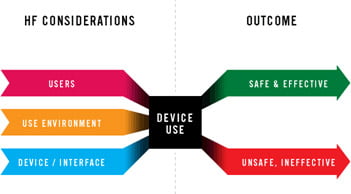HUMAN FACTOR STUDIES
The FDA’s focus on HFE/UE (Human Factor Engineering and Usability engineering) validation and risk mitigation affected by a device design and user manual has resulted in an increased need for Human Factor Studies. As part of risk management in the design phase and with the final finished product, only use by the intended user can verify the mitigation of risk and validate the safe use of your design. Smith Associates’ simulated use studies by the lay person and the professional have assisted many of our clients in their 510k submission. Our study groups include the range of study participants from the professional to the lay user. Visit us on Facebook.
For the results of the human factors validation testing to demonstrate safe and effective use by users in the United States, the participants in the testing should reside in the US. Studies performed in other countries or with non-US residents may be affected (positively or negatively) by different clinical practices that exist in other countries, different units of measure used, language differences that change the way labeling and training are understood.
FDA Guidance – Applying Human Factors and Usability Engineering to Medical Devices
Human Factors and Design Control
Human Factors/Usability and the 510k Submission
Human Factors Services for HF/Usability and HF/Label Comprehension
- Preparation of protocols, case report forms and Administrative plans for IDEs (Investigational Device Exemption) for human clinicals
- Preparation of protocols, case report forms for Human Factor/Usability studies, and simulated use in the clinical environment
- Submit protocol to the FDA via the Pre Sub, if required
- Recruit the appropriate study participants (Adult, Adolescent and Pediatric lay users) for your lay user study from our extensive database of lay users
- Recruit the intended user clinicians for Simulated Use study to validate safe use by intended user
- Recruit appropriate study participant for a disease specific study (e.g. diabetic patients for s User Performance or Accuracy study for BGMS)
- Conduct the study in the required use environment
- Study conducted by experienced study staff to ensure protocol requirements are met
- Training for study participants as required for product type
- Collect and organize all study data
- Prepare the final report for the design control verification or for a 510k submission or PMA
FDA Definition of Simulated Use Testing
“Simulated use testing (also called usability testing and, occasionally, user testing) involves systematic collection of data from users (participants) using a device (or device component or system) in realistic situations. Data are obtained in a variety of ways, including subjective user feedback, manual and automated measures of user performance, and direct observation.”
